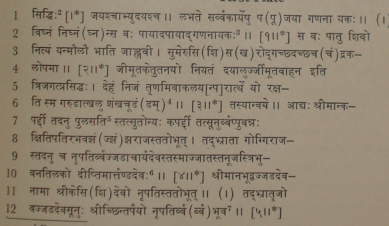|
The Indian Analyst
|
North Indian Inscriptions |
INSCRIPTIONS OF THE SILAHARAS OF NORTH KONKAN
the learned Brāhmaṇa Gōvinda of the Ṛigvēda śākhā and the Kāśyapa gōtra, who was residing at Dīpakāgara. He was a son of Saudapaiya of Tīpaka. The grant was made on the occasion of the Uttarāyaṇa or Makara saṅkrānti which occurred on Monday, the eleventh tithi of the dark fortnight of Pushya (i.e. Pausha) in the expired Śaka year 949 (expressed both in words and figures), the cyclic year being Prabhava. ..The date appears irregular. The cyclic year corresponding to the expired Śaka year 949 was, no doubt, Prabhava according to the southern luni-solar system, but the Uttarāyaṇa Saṅkrānti occurred at 8 hours, 50 minutes after mean sun-rise on Sunday, the 9 th tithi (not on Monday, the 11 th tithi) of the dark fortnight of Pausha in that year. The Christian date corresponding to the Uattarāyaṇa Saṅkrānti was the 24 th December A.D. 1027. In A.D. 1028 the Saṅkrānti, no doubt, occurred on Monday, the 23rd December, but the tithi was Pausha śu. di. 4, and the cyclic year was Vibhava. ..Unlike other grants of the Śilāhāras, the present one does not mention the contemporary five ministers, except the Treasury Officer (Bhāṇḍāgāra-sēna) Nāgalaiya, who is named incidentally in connection with the scribe Jōupaiya, who was his nephew. As in some other grants, Nāgalaiya is described here as a Mahākavi. .. As for the localities mentioned in the present grant, Dīpakāgara is evidently identical with Divē Āgar, where the plates were found. The vishaya of Mandaraja finds mention also in the Prince of Wales Museum Plates of Mummaṇirāja (No. 15). The findspot of the present grant and the mention of Dīpakāgara as the place of the donee’s residence indicate that the vishaya probably comprised the territory in the vicinity of Divē Āgar. It may be represented by modern Maṇērī, about 7 miles (11.27 km.) north by west of Divē Āgar. Vālāsivāgara comprised in that vishaya, where the orchard was situated, is probably identical with modern Vēḷās, about two and a half miles (4.07 km.) north of Divē Āgar. Tīpaka may be Tivare in the Karjat tāluka of the Kōlābā District.
TEXT[1]
[1] From an ink impression supplied by the Chief Epigraphist.
|
|||||||||||||||||||||||||||||||||||||||||||||||||||||||||||||||||||||||||||||||||||||||||||||||||||||||||||||||||||||
| > |
|
>
|








